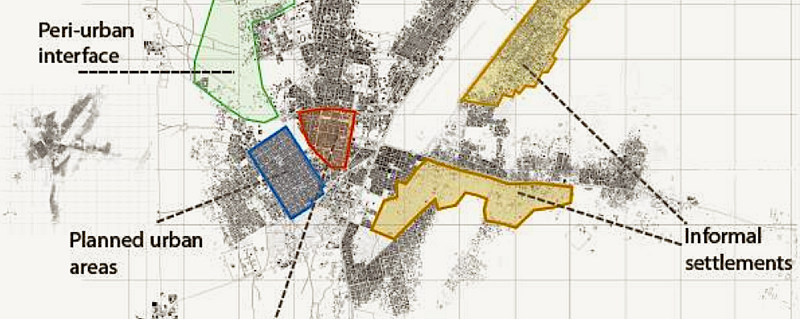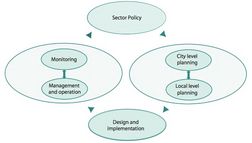Overview
This section outlines the planning process in relation to the activities and outputs from the five stages of the process. These may be undertaken in sequence but in many instances the activities are likely to be iterative and therefore one activity does not necessarily need to be fully completed before the next one is initiated. The steps outlined below are therefore meant to provide guidance on the overall process rather than be a blueprint.
Stage 1: Build institutional commitment and partnership for planning
One of the inherent challenges with sanitation planning and subsequent implementation of city sanitation plans is that they require a range of institutions and organisations to work together. Therefore, the level of commitment, capacity and the relationships between these institutions has a significant bearing on the planning process.
Consequently, the success of the sanitation planning activity will be strongly influenced by the extent of collaboration between the local authorities, utilities and the other stakeholders.
Activities in Stage 1 of the planning process:
- Establish planning process leader and city sanitation task force
- Consultation and facilitation of the process
- Assess key priorities and incentives
- Define a collective vision of sanitation and priorities for improvement
- Agree upon the planning process
Outcome from Stage 1:
The outcome from Stage 1 should be the formation of a Task Force with representation from the relevant stakeholders and agreement between members about their common vision for sanitation improvement and principles that are to govern the way that services are to be delivered.
This should help to mitigate future disagreements about overall policy towards sanitation services in the city and demonstrates their commitment towards improving sanitation services on the ground.
Obligatory: Download and read the full text on Stage 1 [PDF, 3 pages] ›››
Stage 2: Understand the existing context and define priorities
Sanitation plans need to be based upon a good understanding of the existing physical and socio-economic context in different areas of the city that influence the viability of different types of sanitation services. In most settlements, some level of investment in sanitation infrastructure will already have been made, whether by government agencies, households or others. The condition and functionality of these existing facilities will have a strong influence on the options for improvement.
As well as assessing the types of facility / infrastructure that already exist, it is important to learn from the successes and failures of previous projects designed to improve sanitation in the city.
Activities in Stage 2 of the planning process:
- Collect and review information about existing services
- Identify constraints to service provision
- Undertake a sanitation market assessment
- Identify priority areas for improvement
Outcome from Stage 2:
The outcome from this stage should be a clear understanding of problems to be addressed, priority areas for improvement and locations which require service expansion and those that require upgrading. It should also include details of short, medium and long term priorities.
Obligatory: Download and read the full text on Stage 2 [PDF, 5 pages] ›››
Stage 3: Develop systems for sanitation improvement
There are many factors to consider when selecting the most appropriate systems to serve different areas of the city. Decisions need to be based on a good understanding of the existing situation taking into consideration the specific topographic, social, financial and institutional context from Stage 2. Specific attention is required to assure that proposed solutions provide services for all, including those who live in hard-to-serve areas. These are often the areas that challenge conventional service delivery approaches.
This stage in the planning process encourages stakeholders to consider various potential strategies for urban sanitation service delivery; building on existing investments and indigenous knowledge and expertise, but may also seek to embrace technological innovation where these enable a step-change in service level.
Activities in Stage 3 of the planning process:
- Delineate zones for system development
- Consider appropriate toilet facilities
- Develop strategy for treatment, disposal or reuse
- Collection and transportation of wastewater and faecal sludge
- Consider operational and maintenance requirements
- Assess cost of proposed improvement options
Outcome from Stage 3:
The outcome from Stage 3 will be a clear understanding on what types of system are appropriate to serve different parts of the city with a well-developed plan for collecting, treating and reusing the residual waste streams. The cost implications and arrangements for operation and maintenance should also be defined.
Obligatory: Download and read the full text on Stage 3 [PDF, 4 pages] ›››
Stage 4: Develop models for service delivery
The aim of this stage in the planning process is to formulate the most appropriate management arrangements for implementing sanitation improvement strategies in line with the improvement options defined in Stage 3.
Agreement between stakeholders on the proposed institutional and regulatory framework is critical to the success of the proposed sanitation strategy. A consideration of their financial costs in relation to the capital investment requirements is very necessary, but most importantly for sustainable service delivery are the arrangements for cost recovery and management of finances.
Activities in Stage 4 of the planning process:
- Develop appropriate management arrangements
- Derive cost-recovery mechanisms
- Strengthen financing mechanisms
- Develop arrangements for monitoring and regulation
Outcome from Stage 4:
The outcome from Stage 4 should be a number of defined service delivery models that can be adopted by the city to upgrade sanitation services throughout the city. These service delivery models should utilise the agreed technologies for upgrade defined in Stage 3 providing the necessary details to describe the arrangements for management, financing and cost recovery.
The service delivery models should be linked to the institutional arrangements for monitoring and regulation to ensure that service providers meet the agreed service level improvements.
Obligatory: Download and read the full text on Stage 4 [PDF, 4 pages] ›››
Stage 5: Prepare for implementation
The final stage focusses on ensuring that the planning process leads to implementation. After the preparation of the final draft of the city-wide sanitation plan, which should be easily to understand and not open to interpretation, there will be a need for a final consultation activity.
There should be sufficient time available to complete this satisfactorily before moving forwards to the development of the plan for sanitation promotion and capacity building.
The main activities in Stage 5 of the planning process should entail:
- Ensure proposals meet expectations for improvement
- Sanitation promotion, advocacy and awareness-raising
- Capacity building
Outcome from Stage 5:
The outcome from the final stage in the planning process should be the final plan itself and an agreed strategy for financing and implementation of the priority components. This should also include specific target actions to promote sanitation through advocacy and awareness raising combined with a well-developed capacity building strategy to support the implementation of specific components of the plan.
Obligatory: Download and read the full text on Stage 5 [PDF, 3 pages] ›››


